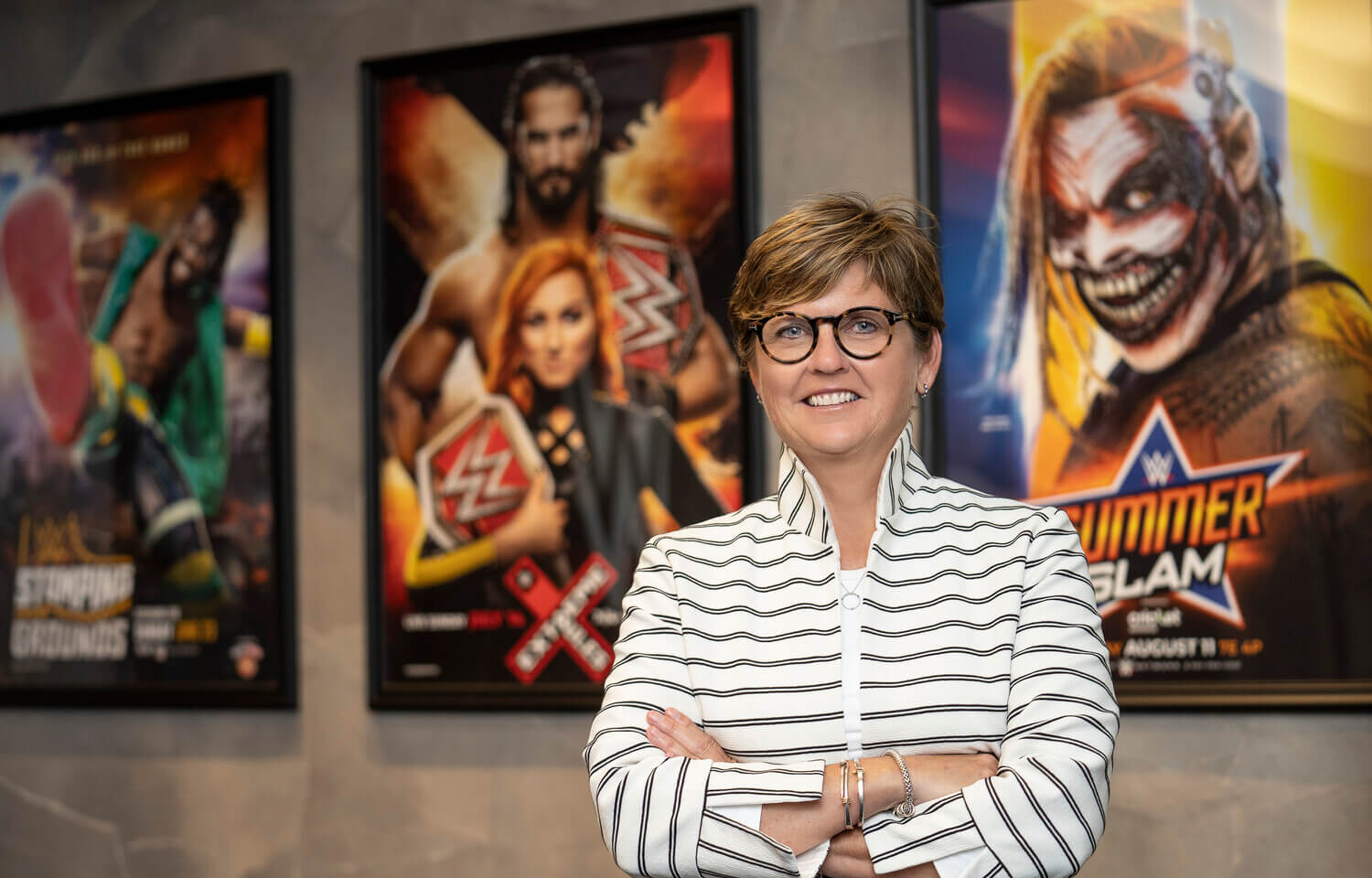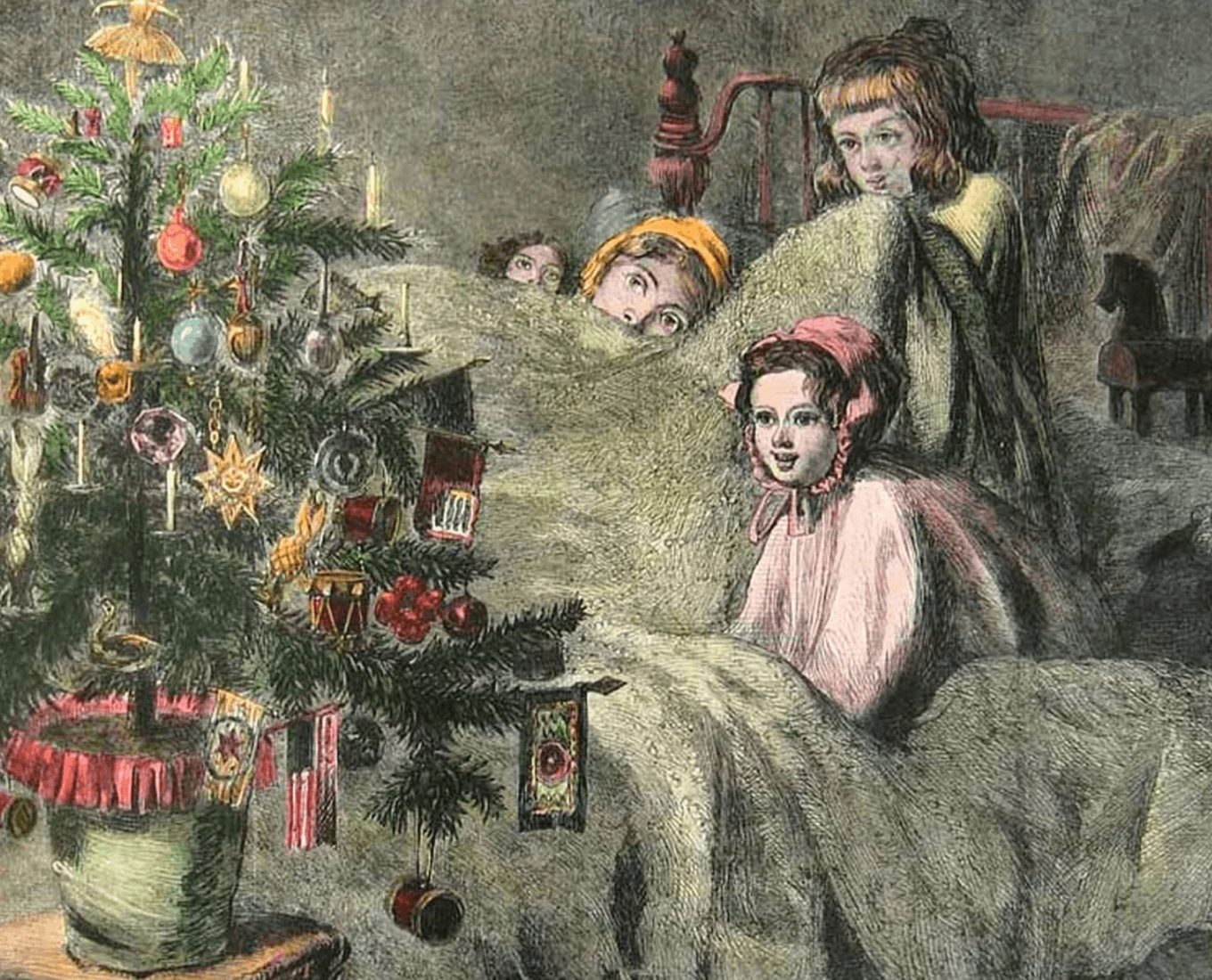Mention billion-dollar international powerhouse World Wrestling Entertainment (WWE) and the thoughts of many automatically land on its colorful characters and eye-popping feats of athleticism. But Mary Ellen Curran '86 says there's another story to tell.
As the company's senior vice president of community relations for the past seven years, Curran and her team have helped focus, evolve and execute WWE's year-round philanthropy, honing its already longstanding charitable work into a framework of pillars that are most important to the company: inclusion (bullying prevention and diversity), empowerment (communities and youth), service (to country and community) and hope (critical illness and pediatric cancer). It's an approach Curran says is designed not to give publicity to WWE, but to the charities and programs with which they partner, from Make-A-Wish and Susan G. Komen to the Boys & Girls Clubs of America, Special Olympics and more.
"No corporate partners get the kind of visibility that our community partners get," she says, noting the publicly traded (NYSE: WWE) global media company has 1 billion social media followers and is broadcast in 28 languages across 180 countries, in addition to its two weekly highly rated cable TV shows, digital platforms, groundbreaking over-the-top streaming service and much more.
The translation of that reach is astonishing: In 2017, WWE generated 3.1 billion impressions, held 237 community events and donated more than $25 million in media value to its community partners. And its work has not gone unnoticed: Last year, the 39-yearold company received the League Humanitarian Leadership Award at the Sports Humanitarian Awards, presented by ESPN.
When WWE partners with a charity, such as Susan G. Komen in May and October, Curran says the Komen logo will be found in every aspect of the company's presence: from its social media and digital platforms and specially branded merchandise to even the lapel pins worn by on-air talent and the ring skirts.
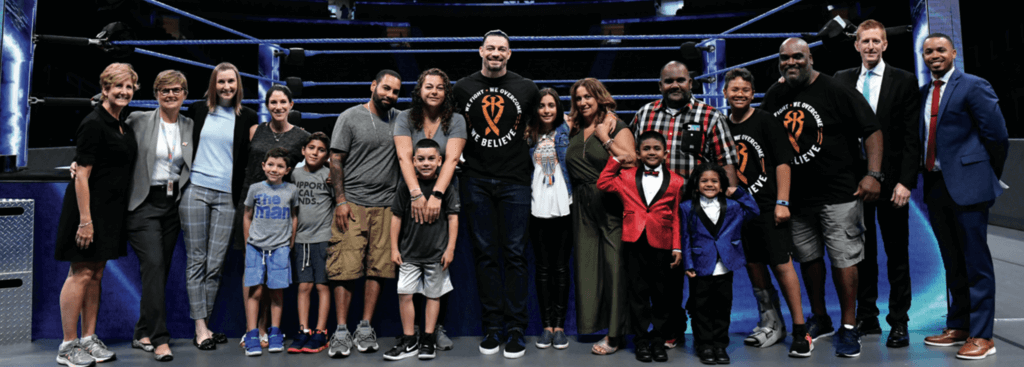
"We try to use every piece of our business to be able to tell the story and tell the story in a meaningful way, because at the heart of our business, we're storytellers," she says. "It's about getting people to understand that, as an organization, we care and we want to make sure that we can make a difference."
The Road to Sports Entertainment
"I played sports my entire life and I played tennis at Holy Cross. And so, I was, like, 'Oh, well, maybe I'll go into sports,' not knowing exactly what that meant." That spark translated into a position with the New England Lawn Tennis Association and the United States Tennis Association, where she did everything from running leagues and tournaments to marketing and brand management, eventually moving to positions with the NHL, NBA and WNBA.
"Most of my career has been in some facet of sports, whether it's programs, consumer products/licensing, sponsorship, sales or partnership management. It really has been a journey that took me then to community relations," she says. "All the previous experience really gave me the bandwidth and the understanding of the business in a lot of different areas."
In 2012, Curran was assistant vice president of philanthropy at insurance company The Hartford when she received an unexpected call from a former NBA colleague who had joined WWE. The company needed a leader to build a framework and growth strategy around its longstanding charity work — was she interested?
"I ended up saying, 'No, I have a job. I have a very good job. I don't need a job.' He convinced me to come at least interview. So I came," she says with a chuckle. "The more I thought about it, I'm, like, 'You know what? It's an opportunity.' It's another challenge where I could come in and help create what the company needs in order to overcome some of the challenges that they were having. I've been here seven years."
Creating a Strategy and Dispelling Misconceptions
What Curran found when she arrived at WWE headquarters in Stamford, Connecticut, was good work being done, but there was an opportunity to further maximize it. While the company had long-term relationships with nonprofits, its efforts were flying under the radar.
"WWE gave back to the community because the company believed it was the right thing to do," she says. "They didn't need to pat themselves on the back or promote these efforts. There was a lot of good work being done and a lot of equity in partnerships that they had for years and years, but they just didn't talk about it."
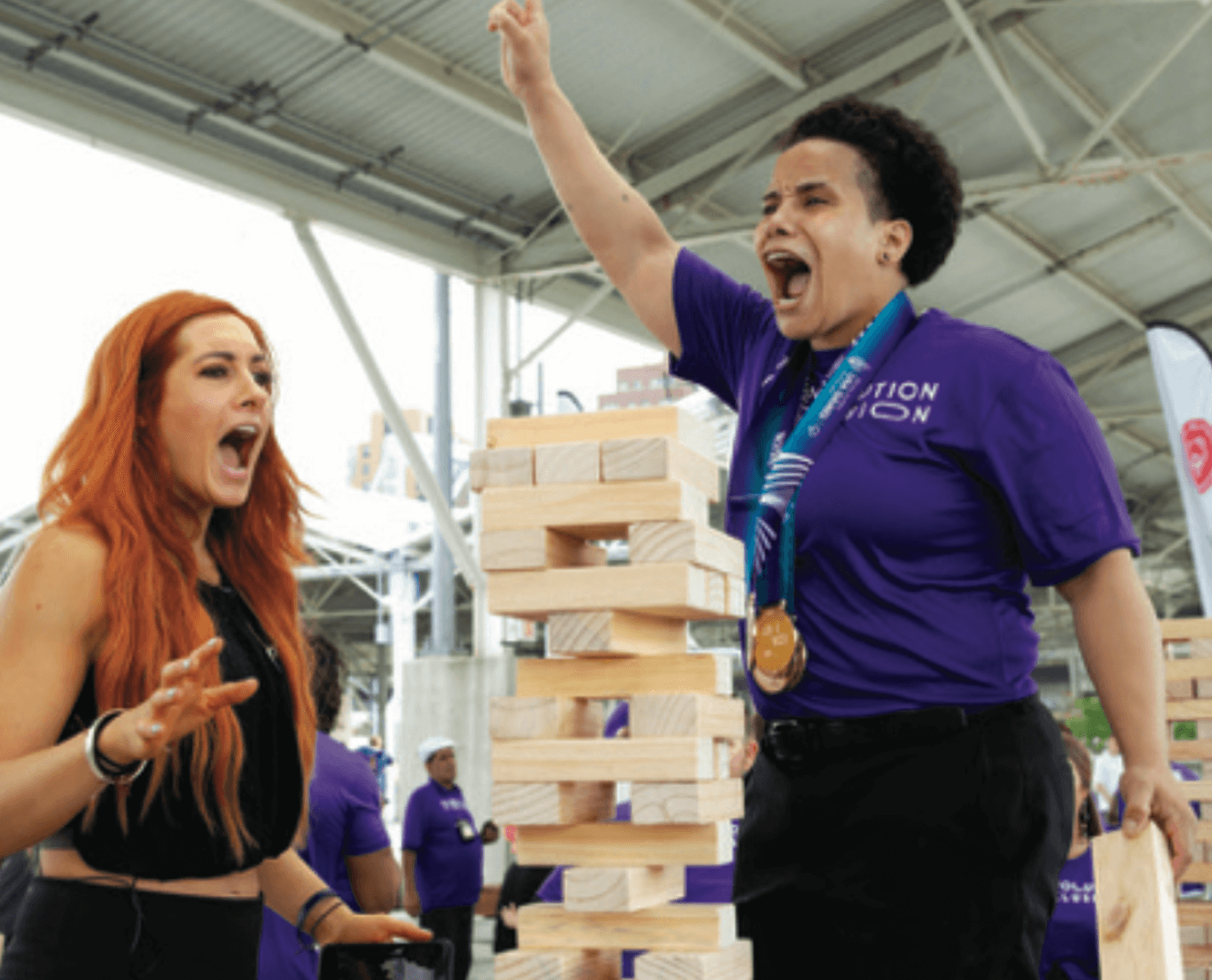
But Curran and other colleagues, such as then-CMO (now co-president) Michelle Wilson, saw the company was missing an important opportunity: the ability to promote their charitable partners by publicizing their relationship with WWE.
"They were doing their partners a disservice because it wasn't about WWE, it was about Make-A-Wish, or Special Olympics, or Boys & Girls Club. It's about the work that they do that we can shine a spotlight on," she says.
But, for some, that spotlight wasn't always welcome, due to the company's reputation. While the brand hit the U.S. cultural mainstream in the 1980s via the Hulk Hogan era, in the 1990s its popular cable shows followed racier, more adult storylines, earning a TV-14 rating. In 2008, the company went TV-PG with family-friendly programming.
"Education was a challenge. When I first came here, I would try and call organizations to say we'd really like to talk to you about a potential partnership, and they're, like, 'Yeah, we don't think you're a fit,'" she notes. "They see the characters who are larger than life, who are flying in the ring, who are doing amazing athletic moves and who are also telling a story. People are so focused on the story that sometimes they don't realize that we're a company that also has given back since our inception," Curran says. "When you talk to someone and you tell them what the company does from a community perspective, they're blown away because they don't understand that this is something the company's been doing, or that we're continuing to bring on partners that we feel have the capacity to make a difference, or to change an issue that is really important to us as an organization."
With a strategic framework established, Curran's team now has a new goal. "Our fans know and love the fact that we're a company that has given back and continues to give back. But now we have to rely on our partners to help us get outside of our world," she says. "For us, now it's: How do we communicate that outside our universe to make people really understand what the company is doing? And that's how some of these major blue-chip nonprofits can help. They give us more credibility because of the brand recognition for Make-A-Wish or Special Olympics or Boys & Girls Club as a strong nonprofit organization that's delivering."
Hitting the Road
Curran and her team of seven create an editorial calendar for the year, deciding when to time partnerships with natural opportunities, such as The V Foundation and Connor's Cure in September (Childhood Cancer Awareness Month), GLAAD in June (Pride month) or Tribute to the Troops, held on U.S. military bases during the holiday season. Filling in the days and weeks are more partner events, which could be as close as WrestleMania in New Jersey or as far flung as the Special Olympics World Games in Abu Dhabi, as well as intimate events such as children's hospital visits or Make-A-Wish.
WWE has been involved with Make-A-Wish since shortly after its 1980 founding, granting more than 6,000 wishes in almost 30 years. Company mainstay John Cena, whose merchandise bears his motto, "Never Give Up," holds the record for granting the most wishes of any celebrity in the nonprofit's history: 600 and counting. And because the WWE has no off-season and operates year-round, it's a charitable calendar that never ends.
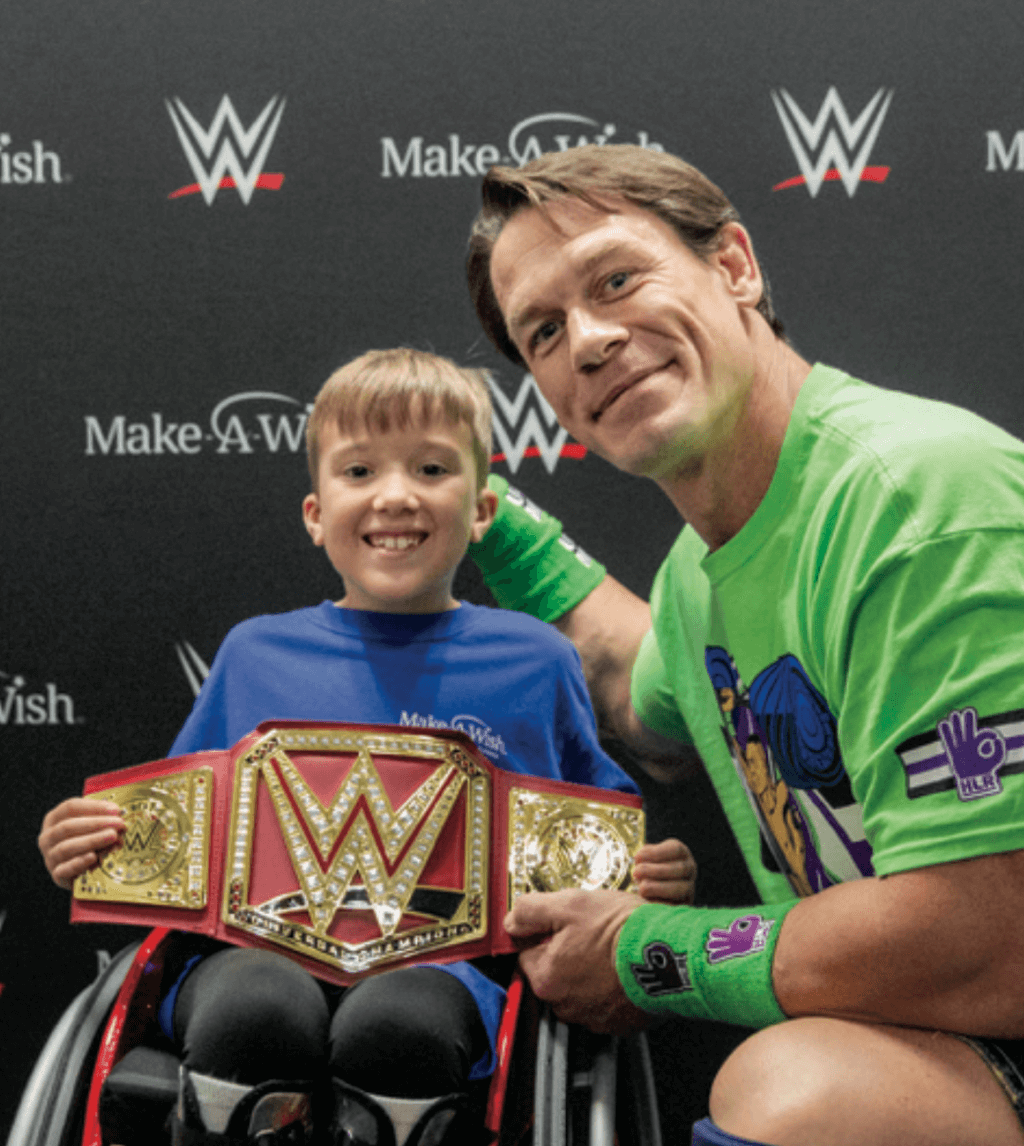
"There's a lot of hours," she says. "A lot of travel."
The backbone of any partner program or event is the company's athletes, who attend solely due to their own desire, rather than a contract stipulation or job requirement.
"They're not required to do a certain number of community events," Curran says. "You don't have to prod them. They are there, they are on, they are engaged with whoever it is that they're working with. They do amazing feats in the ring, but at the same time, they can communicate in a way like no one I've ever worked with. You don't have to ask them twice."
Curran points to top WWE Superstar Becky Lynch, whose passion is working with Special Olympics athletes: "She loves the athletes and competes against them. There was one event where she and one of the Special Olympics athletes were playing giant Jenga. Well, you would've thought that this was the giant Jenga championships of the world between them. It was so intense, but that's her.
"Our purpose is to put smiles on faces, the world over," she continues. "And whether we do that through what you watch on TV or in the arena, or what we do in the community with our community partners, it really is about putting that smile on a child's face who might be having a hard day, or a child who's struggling with cancer or someone who's just been bullied by someone down the street."
The secret of the company's intergenerational, international appeal can be found in the roots of storytelling from time immemorial: "It's good overcoming evil, and ultimately the story is going to end where good overcomes evil," Curran says. "And that's why I think there's such a close connection between some of our fans and our partners who can connect with that. Make-A-Wish, for example: Kids can connect with that largerthan-life superhero who tells them to never give up. The kids who are going through cancer have a way to deal with their illness by emulating their favorite superstar."
And it's that connection that keeps Curran maximizing in-ring talent for good outside of the ring.
"There's those stories that make it easy for you to stay here for seven years," she says. "I kid around that I passed my expiration date twice, but the team that I work with that makes me want to be here for them, the partnerships we've established, what we can do for them and the exposure we're providing to them. And, then, when you see that Special Olympics athlete smiling from ear-to-ear because they got to row a dragon boat next to Becky Lynch, what more can you ask for? It's pretty amazing — I love what I do."
Written by Melissa Shaw for the Fall 2019 issue of Holy Cross Magazine.
